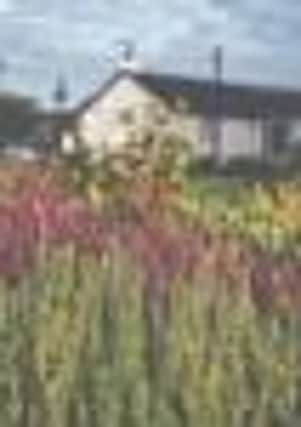With their passion for Alpines, George Watt and Sue Simpson’s Ayrshire garden is the perfect place to put down roots


Only from here, once you’ve climbed a flight of stairs and made your way over a partially boarded floor, do you understand the full extent of the couple’s achievement.
In the foreground, generously proportioned rock and scree beds – their carefully placed rocks and stones gleaming in the rain – stretch out towards a large grassy area, defined with wide mown paths and planted with a variety of trees and shrubs. There is a large raised area, which forms an ericaceous garden, and nearby, the beginnings of a small formal garden enclosed by a hedge of western hemlock. To the east, the restored single-storey house boasts garden views, a place to plan new ideas.
Advertisement
Hide AdAdvertisement
Hide AdNot that the ideas are lacking. In the courtyard formed by the L of the house is a formal paved garden furnished with a collection of old stone troughs packed with Alpines: saxifrages, primulas and dianthus are favourites. The couple, both long-term members of the Scottish Rock Club, share a passion for rock plants, superseded only by George’s passion for trees. Admitting they looked long and hard before purchasing Burnside, so named for the Drumbowie Burn that rushes between the side of the driveway and the woodland garden, both Sue and George say they had no idea of the challenges that lay ahead.


“There are lots of challenges in this triangular garden,” explains George, who studied at horticultural college Auchincruive. He is a great raconteur, whose stories about the garden and the provenance of plants is confirmed by the labels tucked under each one; with names, details of acquisition and date of planting carefully noted. The main challenge, he says, is that the slightly sloping site is underlaid with clay. “The wind tunnels through from both north east and south west, and the land is poorly drained.”
They also had to contend with the power lines and a row of pylons that march across the landscape, but your eye is cleverly drawn down towards plantings of cornus mas and amelanchier canadensis. “And then there was the fauna, including hares, moles, voles and deer.”
The reality of flooding, and the need to rework and relay hard standing due to lack of drainage, even in places where they did not anticipate problems, were major concerns. However, George and Sue, whose passions are clematis and herbaceous perennials, kept working. Pine windbreaks were planted and plastic mesh erected as windbreaks. Drains were relaid, and the rock and scree gardens built using stone from a nearby quarry and punctuated for height with interesting varieties of larches and pines: squat Larix kaemferi ‘Wolterdingen’, pendulous Larix decidua ‘Puli’, rounded Pinus heldreichii ‘Smidtii’ and Pinus bungeana, chosen for its striking bark.
In the field you wander past unusual oaks, Quercus ellipsoidalis ‘Hemelrijk’ famous for its autumn colour, Q. risophylla from the mountains of Mexico and, by the new iris bed, the large-leaved Q. dentata ‘Carl Ferris Miller’. Nearby there is a group of Pinus nigra, which fulfils the dual roles of providing shelter and providing a dark background for the Cornus mas. Three outstanding pendulous conifers also complement this area, Picea breweriana, Picea smitheana, and the compact Cupressus nootkatensis ‘Strict Weeper’.
Behind the large green shed, a pond and raised bed are under construction, alongside large herbaceous beds and a stand of Metasequoia glyptostroboides, “which cope well with the wet and will ultimately screen the shed”, George explains. A nearby hawthorn hedge has already been festooned with honeysuckle, clematis ‘Bill MacKenzie and Rosa filipes ‘Kiftsgate’.
After a walk round the front of the site there are still plenty of surprises: behind the hard standing sit the large poly tunnel and the cosy shed where Sue spends many hours indulging her love of propagating, growing plants like the yellow flowering Clematis repens, C. chiisanensis and even purple Tibouchina urvilleana.
Judging by the plans George expands on as we walk round the garden, including more tree planting, and a bridge over the burn at the foot of the woodland walk to create a circular walk back to the entrance, there is lots more to do. In the spring, the woodland garden is filled with snowdrops, narcissi, erythroniums, wood anemone, trilliums, winter aconites, crocus and cardiocrinum alongside magnolias, acers – including those must have species A. griseum and the golden A. shirasawanum ‘Aureum’ – and rhododendrons. At this time of the year, you can still see the ten-inch stalks of recently flowered Lilium superbum and scattered clumps of purple colchicums, including frilly Colchicum agrippinum. Camassia shrug off the wet to naturalise well, as do Fritillaria meleagris and Anemone blanda.
Advertisement
Hide AdAdvertisement
Hide AdSue propagates most of the plants, starting in November and often sowing 400 types of seed, obtained from seed exchanges such as the Scottish Rock Garden Club.
“Fortunately they don’t all happen to be viable,” she laughs, adding that it was George’s vision and knowledge that allowed them to progress the garden. For his part, George says: “A lot of older people downsize but we feel this is the way to live; to keep going and have fun. The super thing is that we started with a clean canvas, the downside is that you are responsible for anything you create, and you can’t blame anyone else.” k
Burnside, Little Mill Road nr Drongan is open by appointment (01292 592 445, [email protected])